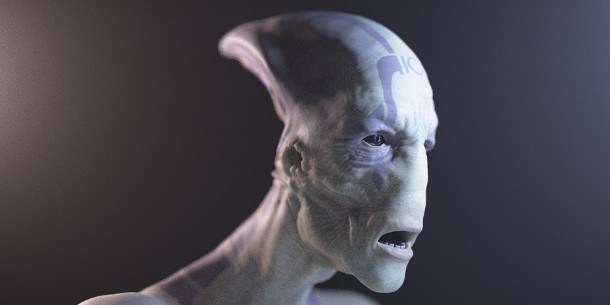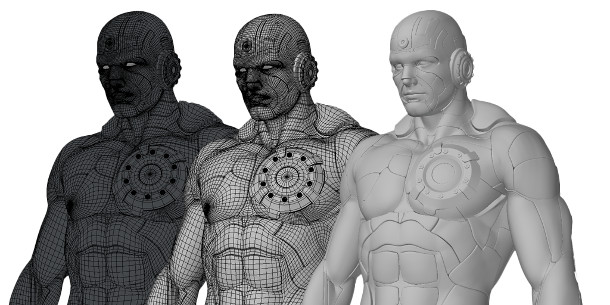NewTek previews LightWave 2016

An early test image from LightWave’s new PBR render engine, showing off the new skin shader. NewTek has just set up a development blog to discuss other upcoming features in the next release of the software.
Originally posted on 5 October 2015. Scroll down for updates.
NewTek has launched a new blog dedicated to discussing dev work on LightWave. The first post teases some of the new features in the next release, including new render and ‘unified geometry’ engines.
Not necessarily LightWave 2016, but that’s what we’ll call it here
Last week, we reported on NewTek’s change of pricing for upcoming versions of LightWave, and summarising recent forum postings about new features due in the next release of the software.
Neither those forum posts nor the new blog gives that release an official version number, but for the sake of simplicity, we’ll refer to it here as ‘LightWave 2016’.
The first blog entry builds on the original forum posts, adding a few more details about the new render engine and the unification of the two applications that currently make up LightWave: Modeler and Layout.
The ‘Borg Queen’ development philosophy
On the blog, LightWave 3D Group president Rob Powers discusses what he describes as his ‘Borg Queen’ development philosophy for the software, proposed prior to the LightWave 11.x series of releases.
“In the same way [Star Trek’s] Borg technology grows from the inside until it takes over the system, [it] allowed us to develop radically different technology without worrying too much about the … current architecture.”
“Progressively, more and more tools would begin to use the new tech until we reach a point where the older technology can be ‘unplugged’ and deprecated leaving only the new more advanced system in place.”
While many users regarded LightWave 2015, which followed the 11.x updates, as a ‘treading water’ release, Powers hints that significant work was continuing beneath the surface.
“This approach allowed us to make good progress toward our goals without completely going dark for a long period or disrupting the system as we [introduced] LightWave 2015.”
Upcoming features: new PBR and volumetric render engine
One of the results of that progress would seem to be the new “volumetric and PBR” engine: an entirely new physically based render engine, including a new global illumination system, materials and lights.
Most of the key information is contained in the original forum thread, along with a set of early test renders.
However, the blog post does add the information that the new engine will remove the distinction between the Viewport Preview Renderer and final-quality rendering “because those are now the same thing entirely”.
The post credits Antti Järvelä for the work, rather than Electric Image co-founder Mark Granger, lead developer on previous updates of the renderer, although NewTek has confirmed that Granger is still on the team.
Greater ‘geometry awareness’ in Layout
The blog post also adds some more information about the integration of Modeler and Layout, introducing what Powers refers to as the new “unified geometry engine”.
According to Powers, the new engine will give Layout “the awareness of geometry elements such as polygons, edges, and vertices and also the ability to actually create new geometry”.
What the post doesn’t do is discuss whether Modeler and Layout will continue to remain separate applications: an issue over which the LightWave user community has been historically divided.
However, in a forum comment, Powers says that “we are aware of the strengths of a focused environment for the modeling workflow and that does not have to be exclusive to an entirely separate application”.
More details over the coming months
That’s currently it for hard information, although Powers promises a future blog post going into more detail on both new engines.
There’s also no hint at a release date for the next version of the software, although given that Powers says that NewTek plans more posts over “the next few weeks and months”, that may still be some way off.
Updated 22 October: NewTek has posted two videos on the blog showing LightWave’s new render engine in action. The one above shows the skin shader; you can see the volumetrics system here.
Both are recorded in real time on a quad-core laptop. Note the way the VPR now enables a user to mouse over a particular area of the image to refine the render faster.
Updated 6 November: NewTek has posted a new video of the changes to LightWave’s FiberFX hair system.
Fibers are now true raytraced primitives, and can be reflected, refracted, and affected by volumetrics, DoF and motion blur. They can now be assigned any material, although there is also a new dedicated Hair material.
Updated 25 November: NewTek’s latest video shows updates to the modelling toolset – notably, the new Layout Camera View in Modeler.
According to Rob Powers, “One of my biggest workflow frustrations has been having to do the modifications [to an object] in Modeler while guessing that the edits will look correct from the Layout camera perspective.”
As shown from around 00:40 in the video above, the update enables users to synchronise the viewports in the two packages. Propagating changes made in Modeler to Layout looks to be a one-click process.
New modelling tools in Modeler
Other new functionality shown in the video includes a toroid primitive, a LiveArray tool for creating geometric and radial arrays of objects, and a Live Lattice tool – think a flexible version of Maya’s Lattice deformer.
In addition (not shown in the video, but mentioned in this forum post), some tools that previously didn’t work properly in Symmetry mode, like Band Glue and Edit Edges, now do so.
But no new modelling tools in Layout this time round
One change we won’t see in the next release of LightWave is modeling tools within Layout itself – although, according to NewTek 3D content and character technology lead Lino Grandi, this remains an “important target”.
In addition, the underlying performance of the tools in Modeler – for example, the poly count of the largest mesh that can be manipulated interactively – will remain unchanged in the new release.
Updated 2 December: Rob Powers’ latest blog post discusses LightWave’s new unified mesh system.
Much of it covers old ground: the unified mesh removes the underlying architectural obstacle to developing modelling tools inside Layout, but that doesn’t necessarily mean that you’ll see them in the next release.
However, there is one interesting factoid: the unified mesh system is an “improved version” of the mesh system used in ChronoSculpt, NewTek’s tool for sculpting animation caches.
On its release, NewTek claimed that ChronoSculpt could manipulate 10 million polygon objects “with ease”, and Powers comments that “Layout will get the same advantages for memory usage and deformation speed”.
Updated 23 December: NewTek’s new video shows LightWave’s new modifier stack and corrective morphs.
The modifier stack works in a similar way to that in 3ds Max, enabling users to add, reorder or disable modifiers to a mesh non-destructively.
Unlike the existing Deform tab, it works with any deformer, not just plugin-based deformers, and enables users to control the order of execution precisely: for example, meshes can be deformed before or after subdivision.
According to a thread on NewTek’s forum, subdivision, morphing and bone modifiers can only be applied once in the same stack, but otherwise, there are few restriction.
The video also shows off LightWave’s new Corrective Morphs nodes, and some interesting new workflows for correcting rigging artefacts during character animation.
Around 01:00 in the video, you can see two linked character meshes: one being animated, and a second mesh on which corrective shapes are being sculpted, with the changes propagating to the animated character. Neat.
Updated 22 January 2016: NewTek’s latest video shows the changes to LightWave’s render buffer workflow.
New features include the option to preview individual render passes directly in the VPR; and the option to define presets for custom combinations of the buffers exported, along with their individual output paths.
As a side note, the title of the video refers to the new release as ‘LightWave Next’. We’re not sure if that’s now its official title, or just a general description.
Updated 29 March 2016: NewTek has posted a new video showing the performance of the upcoming release of LightWave compared to that of LightWave 2015.
The video shows a noticeable improvement when previewing character animations and playing back MDD files, although neither the blog post nor the forum thread accompanying it put any figures on the speed boost.
According to the blog, the improvement results from the new Unified Mesh System, which “brings immediate performance improvements … particularly with mesh deformations and related mesh data manipulations”.
One other interesting feature not referenced on the blog but shown at 02:30 in the video is that there is also a new Scene Editor, which improves performance when selecting objects within complex scenes.
According to the video, both the new and existing scene editors will be available in the upcoming release.

